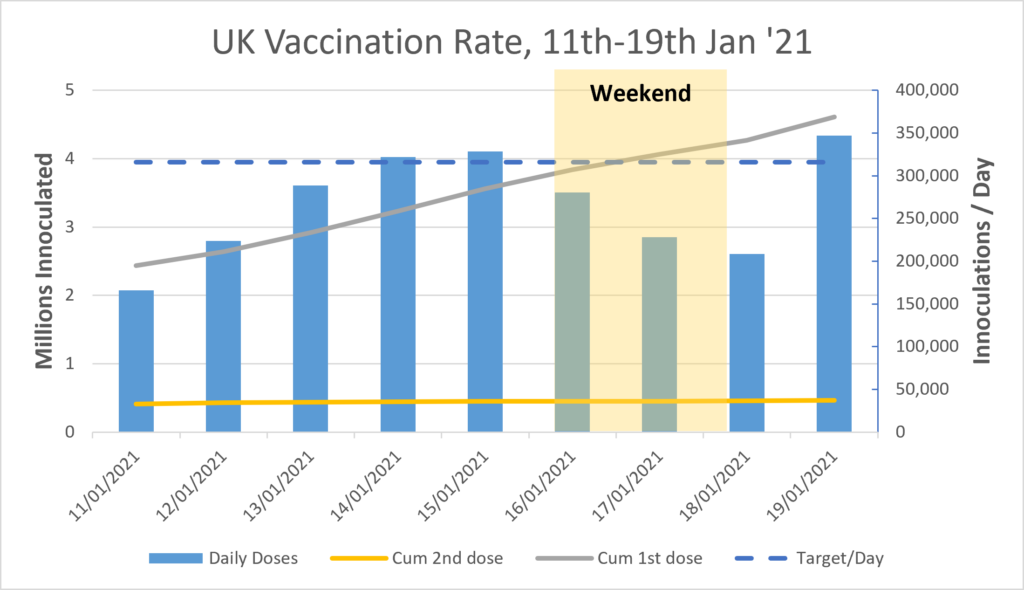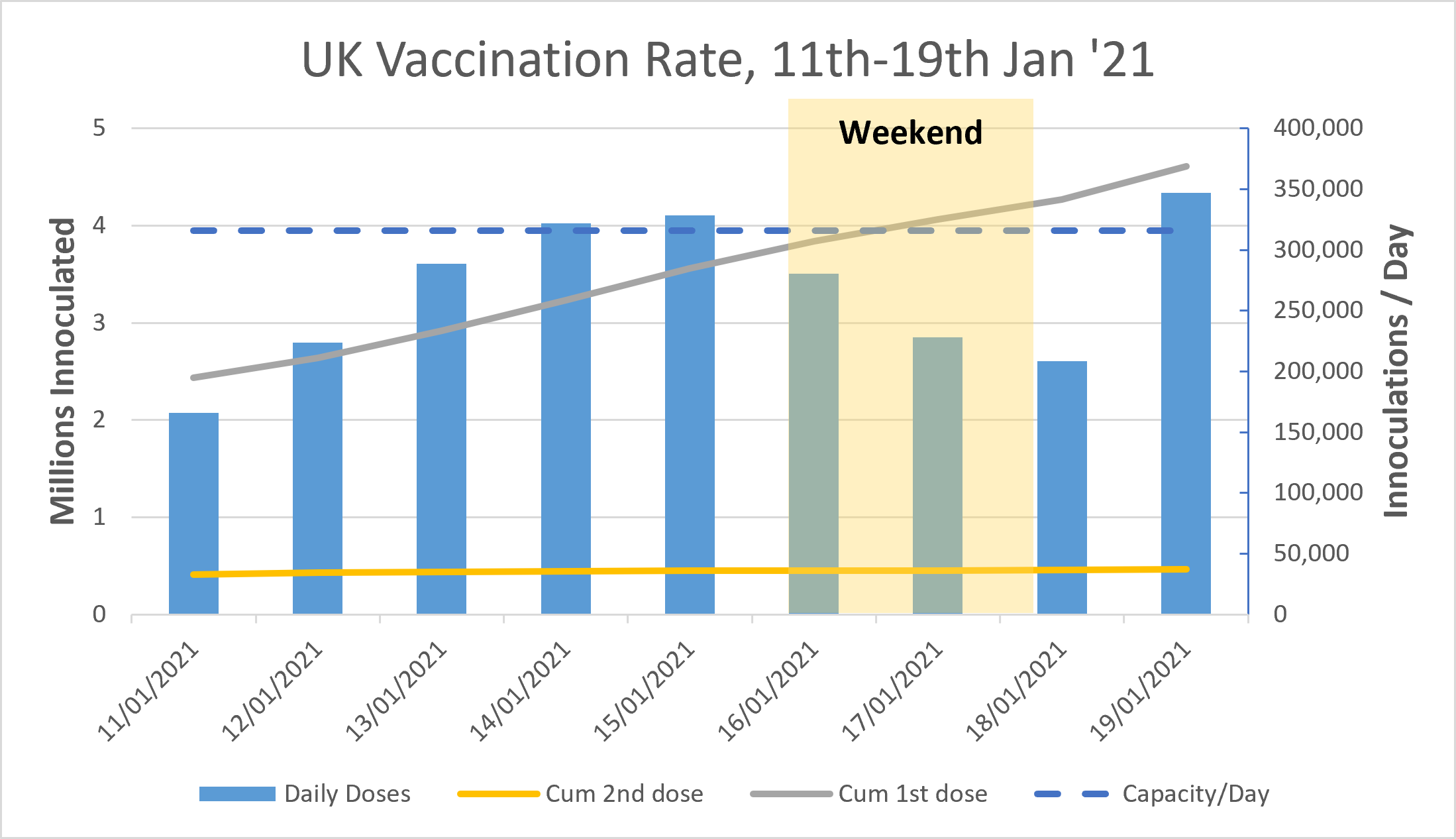21 January 2021
Lies, Damned Lies and Coronavirus
UK Vaccine Rollout
by David Chilvers
 There has been a lot in the media in the last week or so regarding the rollout of the coronavirus vaccine. The UK has now authorised three vaccines for use; the Pfizer and AstraZeneca versions which are already being used and the Moderna vaccine which is reported to be coming on stream by March. The numbers already vaccinated do look impressive and the government has committed to offering all those in the top four priority groups a jab by 15th February. So how realistic is that and how will the plan develop after that initial date?
There has been a lot in the media in the last week or so regarding the rollout of the coronavirus vaccine. The UK has now authorised three vaccines for use; the Pfizer and AstraZeneca versions which are already being used and the Moderna vaccine which is reported to be coming on stream by March. The numbers already vaccinated do look impressive and the government has committed to offering all those in the top four priority groups a jab by 15th February. So how realistic is that and how will the plan develop after that initial date?
There are 13.9 million people in the top four groups. Not all individuals will take up the offer of a vaccine and in the table below I have made assumptions about the percentages that will do so. My estimate for residents of care homes is close to 100%, as in most cases the vaccine will be brought to the care home.
| The vaccine priority list | Individuals | Cum | Take up | Vaccinated | Cum |
| (m) | (m) | Rate (%) | (m) | (m) | |
| 1. Residents in a care home for older adults… | 0.4 | 0.4 | 99 | 0.4 | 0.4 |
|
…and their carers |
0.7 | 1.1 | 90 | 0.6 | 1.0 |
| 2. Aged 80+… | 3.0 | 4.1 | 95 | 2.8 | 3.8 |
|
… and frontline health and care staff |
2.0 | 6.1 | 90 | 1.8 | 5.6 |
| 3. Aged 75+ | 2.3 | 8.4 | 90 | 2.1 | 7.7 |
| 4. Aged 70+… | 3.3 | 11.7 | 90 | 3.0 | 10.7 |
|
… and clinically extremely vulnerable individuals |
2.2 | 13.9 | 95 | 2.1 | 12.8 |
Using my estimates, this brings the number estimated to take the vaccine in the top four groups to 12.8 million people. At the time of writing (Wednesday 20th January), 4.6 million people had received their first dose, so this leaves another 8.2 million people to be vaccinated and 26 days to do it – an average of 316,000 per day.
The number of vaccinations per day since the daily count was introduced has been as follows:
| Date | 1st dose | 2nd dose | Cum 1st dose | Cum 2nd dose | Total doses |
| 19/01/2021 | 343,163 | 3,759 | 4,609,740 | 460,625 | 346,922 |
| 18/01/2021 | 204,076 | 4,565 | 4,266,577 | 456,866 | 208,641 |
| 17/01/2021 | 225,407 | 2,565 | 4,062,501 | 452,301 | 227,972 |
| 16/01/2021 | 277,915 | 2,475 | 3,837,094 | 449,736 | 280,390 |
| 15/01/2021 | 324,233 | 4,027 | 3,559,179 | 447,261 | 328,260 |
| 14/01/2021 | 316,694 | 5,257 | 3,234,946 | 443,234 | 321,951 |
| 13/01/2021 | 278,943 | 9,745 | 2,918,252 | 437,977 | 288,688 |
| 12/01/2021 | 207,661 | 16,065 | 2,639,309 | 428,232 | 223,726 |
| 11/01/2021 | 145,076 | 20,768 | 2,431,648 | 412,167 | 165,844 |

The average daily figure since 11th January has been 266k but the maximum has been 347k on 19th January, above the required rate. The fact that this number of vaccinations has been undertaken confirms that the capacity is there to perform 316k per day and it is probably variation in supply that has been a constraint on other days. Another inference to draw from this table is that two of the three lowest totals so far have been at the weekend, when there may be fewer vaccination centres open.
So, this data suggests that reaching the 12.8m vaccinated goal by 15th February is possible but stretching; expect to see more reference to “being offered a vaccination by 15th February” to provide a few more days after that date to reach the target.
The final inference to draw from this table is that there are virtually no second jabs taking place now, confirming that the strategy is to give as many people as possible a first jab and administer the second one within 12 weeks; this has implications for the roll out to those under 50, discussed below.
To reach the stated goal of vaccinating all the remaining individuals aged 50+ and all vulnerable adults below 50 involves another 19.2 million people and another 15.5 million vaccinations, assuming gradually declining take up rates as age falls. At the estimated 316k per day rate, this will take another 47 days or up to 3rd April. Again, this just meets the soft target of vaccinating all those aged 50+ by Easter.
As shown above only 460k individuals have received both doses and by 5th April, those vaccinated in early/mid January will be reaching the maximum 12-week time interval for their second jab. To give a second jab to all those that have just had one jab will require 88 days, again assuming 316k per day and that takes us to 30th June. By this time, all those aged 50+ that have taken up the vaccination will have received both doses and it will be possible to start on those aged under 50. As there are 19.1 million of these, excluding all those in key groups previously vaccinated (health service and care workers and those extremely vulnerable), this will take another 47 days, taking us to 17th August. This ties in with the Government’s stated aim of vaccinating all adults (once for those aged under 50) by September.
This exercise in arithmetic confirms the feasibility of the three objectives:
- To vaccinate the four priority groups at least once by 15th February
- To vaccinate all over 50’s (at least once) “by the Spring”
- To vaccinate all adults (at least once) by September
The achievement of these objectives depends upon sustaining 316k vaccinations per day, on average, seven days a week throughout this period. This is operationally feasible with the current network of vaccination points as more than this number has been undertaken on a single day already. But sustaining such a high average over a longer period of time will probably require:
- Increasing the number of vaccination points in the network
- Maintaining and ideally increasing the vaccine supply (the availability of the Moderna vaccine by March should help with this and there are further vaccines in the pipeline including single dose vaccines)
The task will be more stretching if the take up of the vaccine is above the average of 80% assumed, falling from the high 90%’s for those aged 70+ to around 70% for those aged 16-49.
In this column I have been critical of the paucity of statistics and, when these improved, of poor insight and inference. But, so far, with the vaccine rollout, data is being shared as promised (daily figures on the coronavirus website) and the targets this time look achievable (compared to the targets for e.g., Test and Trace or Operation Moonshine – sorry Moonshot). Let’s hope so and be sure I will be coming back to this if either the data or the delivery starts to drift from the objectives set out. Keep looking out for that 316k per day to see if the programme is on track.
This article is one of a series, find last week’s article “Excess Deaths” here.


